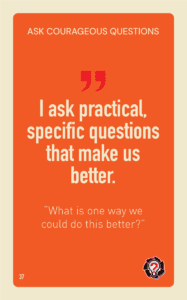 Avoid These Intimidating Questions That Can Silence Innovation and Problem Solving
Avoid These Intimidating Questions That Can Silence Innovation and Problem Solving
When someone on your team screws up or has one of those “what were they thinking” moments, particularly when the stakes are high. You need to figure out what’s going on– fast. In these moments of stress, it’s tempting to shortcut communication with blunt, intimidating questions to get quick answers.
But here’s the challenge: asking intimidating questions can stifle creativity and problem-solving, leaving your people hesitant to share information, let alone ideas to fix the situation.
Intimidating Questions That Disengage Employees
The most dangerous and intimidating questions are those where the asker already “knows” the answer, and just wants the receiver to “get it right.” Closed-ended questions can have a similar impact. It can come across as passive-aggressive to pretend you’re curious when your intent is for your direct report to admit a mistake or agree with you.
Here are a few classic intimidating questions.
- What do I have to do to get you to…?
- Why did you do that?
- Did I ask you to do that?
- Is that really working?
- What is your experience in this area?
- Who gave you the authority to make that decision?
- Is that your final decision?
- Are you sure about that?
- What makes you think that will work?
The Impact of Intimidating Questions
Think about it—when was the last time you felt energized and motivated after someone asked you, “Why did you do that?” The same is true for your team. They feel criticized rather than supported, and this defensiveness leads to less creativity and more playing it safe. Which is the last thing you need when dealing with complex challenges.
Instead of defaulting to intimidating questions that unintentionally shut a team member down, pause and reframe your approach with empathy.
A simple shift from, “Why did you do that?” to, “Can you walk me through your thought process?” changes the entire tone of the conversation. It signals that you’re genuinely interested in understanding their reasoning, rather than criticizing their actions.
The Power of Asking Better Questions
So, what do the right questions look like? They’re questions that help your team think critically, encourage them to explore new ideas, and ultimately guide them toward ownership of the solution. When your team feels safe to share their thoughts, they’re more likely to engage deeply with the problem and come up with innovative solutions.
Here are a few empowering alternatives to common intimidating questions:
Instead of, “What makes you think that will work?” try, “What options have you explored, and what led you to this one?”
Or, Instead of, “Who gave you the authority?” try, “How did you decide this was the right approach?”
Why did you do that?” can become “What were the factors that influenced your decision?”
Or you can try our 9 What’s Coaching Method to help a team member think more critically and solve more problems on their own.
These questions foster a spirit of collaboration. They’re designed to help your team reflect on their thinking, giving them the space to explain their reasoning without feeling attacked. This shift from interrogation to exploration builds trust and encourages problem-solving.
Related Articles:
No More Vague Reports: How to Get Your Team to Give You More Useful Information.
Attention to Detail: How to Help Your Team Have Less “Oops” Moments
Psychological Safety: Why People Don’t Speak Up at Work
Other ways to build stronger, teams who ask better questions of one another
Of course, your team will be stronger if everyone knows how to turn the intimidating questions into ones that come from a place of genuine curiosity. You can find a list of curiosity habits to make your team stronger.
We’d love to help you and your team accelerate performance, reduce stress, and work better together. Learn about our SynergyStack™ Team Development System and SynergySprint Team Retreats.









Great post and so very true. I struggled with this during my first tenure as a team leader, asking ALL the wrong questions. As a result, not only did I shut down my team, I completely lost their trust and willingness to perform. It was was a tough and costly lesson, but I did learn from it.
Moving forward as a leader, I began using questions that opened people up and showed that I valued their thoughts and input. Needless to say that approach was far more effective as my team really became invested in everything we were doing and owned the results.
Bill, thanks so much for sharing your story. I really appreciate you joining the conversation. I like what you add about it helping the team to “own the results.” Exactly.
Great post. This makes me think of how I ask questions to my 7 year old. The questions communicate a message- not just a query.
Marcus, thanks so much for joining the conversation. Absolutely. What and how we ask is also a statement. Namaste.
Questions that shut people down are leading ones and closed ended ones. Your disengaged questions can easily be turned around so they’re engaging. For example, “What do I have to do to get you to” can be modified to say “Who would you like to show up as so you feel great about this project?”
awesome… thanks for adding that. “who would you like to show up as…” I am going to use that one for sure.
I like this post and I agree many questions can be disengaging. In particular – leading questions like: “Don’t you agree that…” or “Isn’t it obvious that…” followed by an opinion or an assumed obvious response mostly make me want to exit a conversation.
Thanks for joining the conversation. You provide some great examples here.
I find it frustrating that ego gets in the way of communicating in intense situations of hurt but I suppose your website is correct- effective communication needs creative questions that empower the other person. What I learned: empowering those that hurt you is very difficult. Compassion can never be forced: so say your words once and move on. Accountability can not be forced either. Creative questions like the one you suggest can save a lot of time from consequences of making someone feel “intimidated”.
Lex, Thanks so much for expanding the conversation and taking the time to comment. Agreed, ego does often get in the way of effective communication during intense situations.